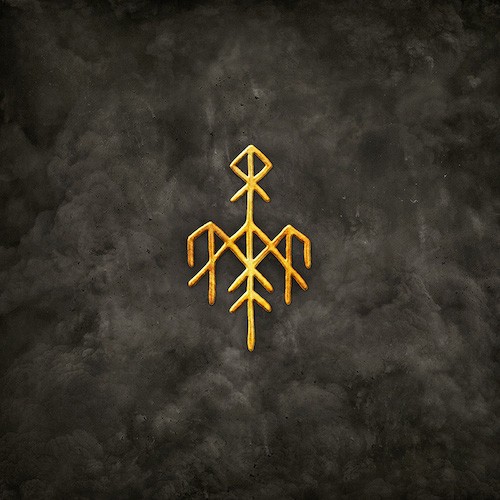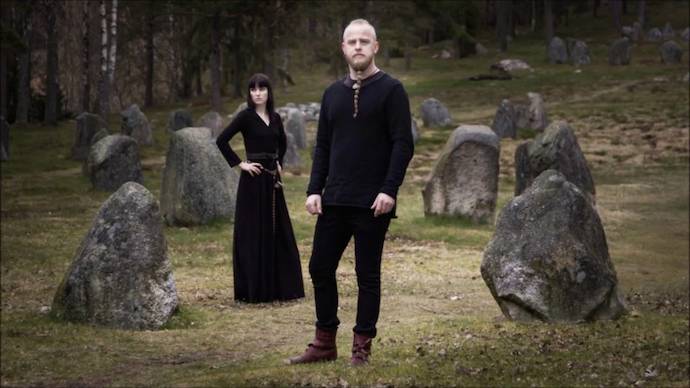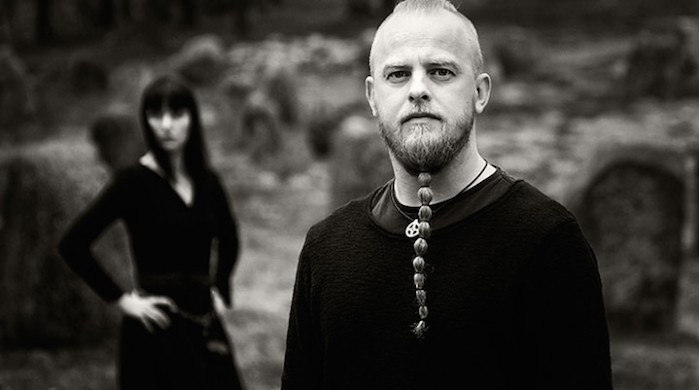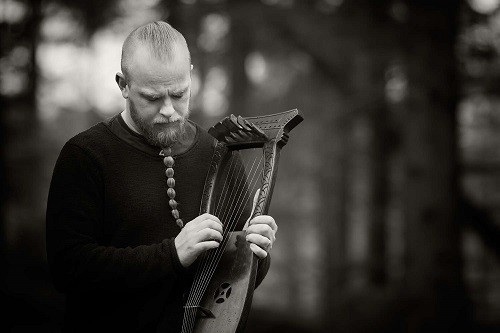(Our long-time supporter and occasional contributor Booker returns to NCS with this review of the new album by Norway’s Wardruna.)
Wardruna are an exception to the rule here. On the one hand, because of the singing, which is not only “clean”, but is often chanted, whispered, or spoken-word, as well as being in a language few of us would understand. And the foreign-ness of it means that the significance of the vocals – the message, or meaning — is simply the rhythm and emotion the vocals produce, rather than the what the words signify – arguably, in that respect, perhaps not too far off a lot of the metal we listen to.
But they’re an exception, too, as you won’t find any distorted guitars here, nor any traditional drum kits, blast beats, breakdowns, or sounds belonging to the mosh pit. But what’s on offer will hopefully move and entice you all the same.
Wardruna are a Norwegian group, headed by Einar Selvik, whose other forays in the metal scene include as drummer for Gorgoroth in the early 2000s, and the recent Skuggsjá collaboration between Wardruna and Enslaved. Wardruna play a kind of Norse folk music; Viking folk would probably be an apt description, and not surprisingly their music was featured on the History Channel’s Vikings show, with Einar also contributing to the show’s soundtrack. Eschewing your typical line-up of modern instruments, the music is instead provided by a collection which could be described as traditional, esoteric, uncommon, or even improvised – a few of which are on display in the video for “Raido” below.
Since 2009, they’ve been producing a trilogy of albums based around the Proto-Norse runes, also known as the elder futhark. On 21 October the final part in the trilogy, Ragnarok, was released via Norse Music. While their music is certainly not the typical fare featured here on NCS, just like The Lord Of The Rings didn’t get a big Oscar nod until the final Return Of The King, the end of Wardruna’s Runaljod trilogy seems like an apt time to pay homage to this unique collection of albums (yes, I’m comparing NCS to the Academy, and the votes from the slow lorises are in).
Ragnarok is the name of an apocalypse of sorts in Norse mythology, featuring various Norse gods in a great final battle, ending with the world being consumed by a great flood, to be later reborn and repopulated by two sole surviving humans. A fitting name, then, for the final album in their Runaljod trilogy.
The first album in the trilogy, gap var Ginnunga, released in 2009, had a fairly minimalistic approach, with a steady, slow-to-mid-paced beat forming the backbone of many tracks. Folk played out over a meditative background approaching ambient drone, with lyrics often whispered and echoed like hallucinations from a fever dream. The overall atmosphere has an ever-present dark undercurrent, but one being grounded in the silent, slow-moving, dark mystery of nature; slightly terrifying yet earthly all the same.
The second, Yggdrasil, stepped up the pace. The tracks here embraced a more typical “song-like” approach. With much more prominent vocals, group chants, more diverse melodies, and female vocals added to the mix, the album brought with it a greater range of moods. Add in a change in rhythm from the solid beat approach on gap… to a more dynamic, varied tempo across tracks, as well as much more distinct transitions between tracks, and Yggdrasil is arguably their most accessible album to date.
Against this backdrop has now arrived Ragnarok. To a certain extent, it feels like a natural amalgamation of the two approaches on gap… and Yggdrasil, and a fitting end to the trilogy. The album starts with what sounds like a bullroarer, before something like battle horns kick in (this sequence is at the start of the “Ragnarok – 21 October 2016” video below). In case there were any doubts, you can tell from the get-go you’re not in for a usual album. As a whole, this release steps back to a more mid-paced, deliberative approach akin to gap…: if this were Rotting Christ, think more Rituals than AEALO. There’s a more meditative feel to the tracks, with segments that wouldn’t be out of place in a film soundtrack.
One thing that has never been missing in a Wardruna album is a depth of mix, but here it feels like they’ve stepped it up even more: the instruments never feel crammed in, each occupies its own place on the stage to produce a feeling of immersion rather than being a spectator. There’s fewer female vocals, but Einar’s children make an appearance (particularly on “Odal”) as well as the Skarvebarna Childrens Choir.
In total, it all contributes to a mood that encompasses Wardruna’s music: you feel that they could well have thrust some recording equipment back through space and time and captured a traditional song being sung by the members of a Viking village during a fire-lit ceremony. Throw in some tribal drumming, quieter ethereal segments like the opening to “Isa”, and random elements like animal sounds and drumming on ice and trees, and you’ve got something that could appeal to a number of readers here: metal in intent, if not entirely in sound; taking your own path and creating a form of art that steps out of the norm, for no other reason than that’s what speaks to you.
We’ve featured the advance track ‘Odal’ on NCS before, and Wardruna have now also released what seems to be their second-ever music video, for the track “Raido”. It’s a beautifully filmed piece, and the track provides a good introduction to what to expect from Ragnarok as a whole: a slowly moving composition with something of a sense of majesty – think music that moves with the breath of the earth, rather than a breakneck pace – and with a mood that seems both dark and mysterious, yet also earthly and grounded.
Ragnarok is available directly from the band’s website (including digital formats):
http://www.wardruna.com/shop/ragnarok.html
http://www.wardruna.com/
https://www.facebook.com/wardruna





Glad to see Wardruna here, even if it feels a bit weird.
I’ve been a fan since the beginning and I bought the album as soon as it was available. While Yggdrasil had an immediate impact on me from the first listen, Ragnarok is taking a few listens to get there. I’m not worried, I know it will deliver flawlessly. Just need to leave the chaos of the office and lose myself in the national park.
Wardruna is one of those bands that make you want to leave all shallow concerns of everyday life (smartphones, computers, meetings, traffic, people) and focus on your real self for a change.
“Wardruna is one of those bands that make you want to leave all shallow concerns of everyday life (smartphones, computers, meetings, traffic, people) and focus on your real self for a change.” Very well said.
Yggdrasil was actually the first album of theirs I heard. And I agree that Ragnarok didn’t quite grab me as quickly as Yggdrasil did on the first listen; they’re quite different albums. But after a bit of time to process it on the weekend, I’m sold.
My love for Wardruna comes in waves. I’ll go for months without listening… then one (typically rainy PNW) day I’ll play them on my way to a trailhead and be obsessed, not just for the hike, but for the weeks that follow.
I’m not just an addict, but also a pusher, and enabler for many. So I’m glad to see people like myself in the metal blog world
I’m most definitely an enabler. And equally guilty of bastardising drug vocabulary when referring to metal. Feed my addiction!